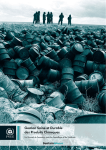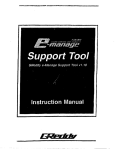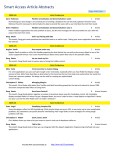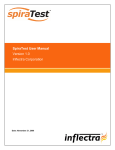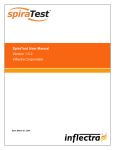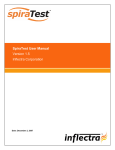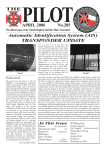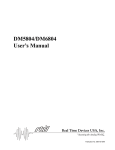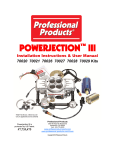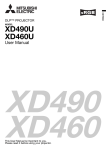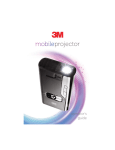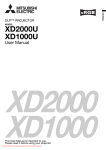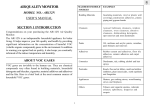Download DC User`s Manual.3_21_05.fm
Transcript
Drift Catcher Users’ Manual Pesticide Action Network Copyright ©2005 Pesticide Action Network All rights reserved. Pesticide Action Network 415-981-1771 www.panna.org www.pesticideinfo.org Contents Welcome! ............................................ 1 Section 1: Getting Started. . . . . . . . . . . . . . . . . . . . . . . . . . . . . . 2 Section 2: The Drift Catcher System . . . . . . . . . . . . . . . . . . . . 4 Section 3: Setting up the Drift Catcher . . . . . . . . . . . . . . . . . . 10 Section 4: Starting the Sample . . . . . . . . . . . . . . . . . . . . . . . . 11 Section 5: Filling Out the Site Information Sheet . . . . . . . . 19 Section 6: Stopping the Sample . . . . . . . . . . . . . . . . . . . . . . . 20 Section 7: Preparing Trip Blank Samples. . . . . . . . . . . . . . . 22 Section 8: Storing the Sample . . . . . . . . . . . . . . . . . . . . . . . . 22 Section 9: Filling out the Chain of Custody Form. . . . . . . . . 23 Section 10: Handling Trip Spike Samples . . . . . . . . . . . . . . . . 24 Section 11: Disassembling the Drift Catcher . . . . . . . . . . . . . 25 Appendix A: Troubleshooting . . . . . . . . . . . . . . . . . . . . . . . . . . . 26 Appendix B: Quick Checklist for Drift Catcher Operation . . . 30 Welcome! We are glad you want to learn how to use the Drift Catcher. This manual provides information on how to set up and use the Drift Catcher to look for pesticides in air. It is intended for use in conjunction with PANNA’s training and certification program for using the Drift Catcher. If something in the manual is not clear, please call PANNA and ask for help. PANNA’s phone number is (415) 981-1771. Ask for Katherine Mills or Susan Kegley. Katherine’s cell phone number is (415) 640-3129 and Susan’s is (415) 999-9071. Important! Page 1 Please read the directions thoroughly before you start! Section 1: Getting Started What you need • • • • A sheltered and secure place to set up the Drift Catcher Access to an electrical outlet (call us if you need a battery-powered Drift Catcher instead) Approximately an hour to set up the Drift Catcher the first time and do a comprehensive site description that includes taking pictures and sketching a map of the site. Once you are familiar with the Drift Catcher system, it will only take about 15 minutes or so to change tubes and record sampling times. A sense of smell and an awareness of your surroundings Page 2 Things to know • • • • Samples are always taken in duplicate—two at a time—to ensure greater precision and accuracy and provide flexibility in analysis of the samples. Careful note-taking is very important to the success of your sampling. If you do something that is not exactly like the instructions, be sure to write it down. If you make a mistake, all is not lost! But it is very important to write down exactly what happened so you don’t spend money analyzing a sample that may not give you valid information. Pesticide concentrations in air are highest during and soon after applications. For your safety, it is best to stay far away from locations where pesticide applications are occurring. If you wish to sample a particular application, start the sampler before the application begins, then leave the area to avoid exposure. Alternatively, begin sampling after the application has ended and the spray drift has settled. Important! • While it is optimal to take samples while pesticides are in the air, your safety comes first. The pesticides you are catching could be harmful to your health, and you should be aware that exposure to pesticides can occur not only by breathing , but also through skin contact . It is important to minimize the time you spend near an application site. If you have questions, please call PANNA at (415) 981-1771. Page 3 Section 2: The Drift Catcher System How it works The Drift Catcher works by using a small vacuum pump to pull a known amount of air through a sample tube that traps pesticide spray, dust, and vapors. Figure 1 shows how the device works. Figure 1: This diagram shows the air flow through the Drift Catcher. Airborne pesticides are pulled into the sample tube, where they are trapped . After sampling is complete, the tubes are sent to a laboratory for analysis to determine the amount of pesticide present. Once we know both the amount of pesticide trapped and the volume of air pulled through the tube during the sampling period, it is possible to determine the concentration of pesticides in the air, usually in units of nanograms of pesticide per cubic meter of air. Page 4 Parts of the Drift Catcher Kit Large Plastic Box Contains: • • • • • • • • Manifold with bracket and tube adapters (Figure 2 and Figure 3) uum pump (Figure 3) Metal stand Extension cord (50 or 100 ft.) Tape measure (100 ft.) Shipping box with cold packs Clipboard Pictures to help you re-pack the kit when you are finished sampling. Small Parts Box Contains: • • • • • • Rotameter (Figure 3) Light shields (Figure 3) Glass sample tubes and red end caps (Figure 3) in Ziploc bags with Sample Log Sheet and tube labels. Extra tubes and labels. Tube cracker (Figure 3) Battery-powered compass (Figure 3) Wind/temperature meter (Figure 3) A Manifold B Valve Knobs Sample Tubes Figure 2: Page 5 The Drift Catcher sampling manifold allows you to take two samples at once. The valve knobs control the air flow through the sample tubes. Vacuum pump Rotameter to measure air flow Glass sample tube with caps Rotameter adapter Tube adapter Light shield Tube cracker Compass Figure 3: Wind & temperature meter Parts of the Drift Catcher kit include a rotameter to measure air flow, glass sample tubes that trap pesticides, light shields to protect the sample tubes from light that might degrade the pesticides, various adapters to connect the tubes to the manifold and the rotameter, a vacuum pump to pull air through the sampling tubes, a tube cracker, a compass and a wind/ temperature meter. Page 6 How long should you sample to get the best results? Since you do not know the concentration of pesticides in the air before you take the samples, you have to use your sense of smell and any extra information (like when an application might have occurred) to determine the optimum length of time to sample. In order to be able to compare your results with Reference Exposure Levels (“acceptable” levels determined by U.S. EPA), you must sample for a total of 24 hours. This can be accomplished in several different ways—with a single 24-hour sample, or if you are expecting high concentrations, you might change the sample tube several times during the 24-hour period (see Figure 4). If you change the tubes too often though, you may not trap enough pesticide to be able to detect it in the laboratory analysis. Figure 4: There are many different possibilities for timing sample collection. Two common sampling schemes are shown in this figure. Sampling times will typically depend on how much time has elapsed since the application occurred and how close the application is to the sampling site. If the application happened within the previous half-day within several hundred yards of the sampling site, a good plan would be to pull air through one set of tubes for four hours, change to a new set and leave it in place for another four hours, then another set for four hours, 12 hours, 24 hours and 24 hours, for a total of three days (see Figure 4). If you are not able to sample during and/or soon after the application, but know pesticides were applied within the last day or two, take three backto-back 24-hour samples. The 24-hour samples also work well to estimate longer-term exposures over the course of several weeks to several months. Page 7 Dividing the sampling time into smaller blocks can help showconcentration peaks, but concentrations must be relatively high to get good results for sampling times less than 24 hours. Obtaining a 24hour background sample before the pesticide application occurs is very useful if you can do it, although this may be impossible if you don’t know when the application is scheduled to occur. Figure 5: A typical plot of concentration over time for a semi-volatile pesticide. Forms you will use To make it easy to record information about the site and the samples, we provide the following forms. 1. Site Information Sheet Use this sheet to record information about the sampling site. Include distances to potential sources of pesticide drift and to locations where people may be exposed. If you observe any nearby pesticide applications, use the Site Information Sheet to record the time the application was made and describe the application (how the pesicide was applied and identity of the products, if you can find out). It is also helpful to note any additional chemicals/pesticides that might have been used or stored near Page 8 or in the sampling location that might interfere with the pesticide analysis. Such interferences include mosquito-repellent candles or coils, insect repellent, solvents, air fresheners, toilet bowl deodorizers, paint thinner, other solvents, smoke and dust. See Section 5: Filling Out the Site Information Sheet on page 19 for more information on filling out the Site Information Sheet. Important! Do not use any other chemicals in or around the sample site during the sampling period. 2. Sample Log Sheet The Sample Log Sheet is used to record information for each sample taken. • • • • Start time and stop time for each sample Air flow rates at the beginning and end of each sampling period Weather, wind, and temperature Odors and other observations, especially about the timing of pesticide applications, or notes about problems with that particular sample. 3. Freezer Log and Chain of Custody form The Freezer Log sheet is taped to the door of your freezer so you can make a note of the time each sample is placed in the freezer. The Freezer Log sheet also serves as your Chain of Custody (COC) form, which always stays with the samples to track where they have been, how they have been stored (on ice or dry ice or in a refrigerator or freezer), and who has had responsibility for holding them. If you ever want to use the results of a sampling run in a court case, you must have a valid Chain of Custody form. See Section 9: Filling out the Chain of Custody Form on page 23 for more information. Remember! It’s very important to write down what you do and what you observe. Page 9 Section 3: Setting up the Drift Catcher Set up the Drift Catcher in a location where you wish to measure pesticide concentrations in the air. For example, you might want to sample a child’s play area, your front yard, deck or porch, or near the edge of your property boundary. You can use the Drift Catcher inside, but it is best not to set the system up in the kitchen because smoke from cooking can interfere with the laboratory analysis. It is also best to avoid setting up the Drift Catcher in areas where people smoke. Be sure air can circulate freely near the Drift Catcher—don’t put it right up against a wall or a fence if you can help it. The pump makes some noise, so take that into consideration when you decide where to put it. Be sure the Drift Catcher is secure from theft and that the pump is protected from rain or direct sunlight. 1. Check that the extension cord can easily reach the pump. Plug in the extension cord but do not plug in the pump just yet. Assemble the stand by placing the 18-inch pole into the flat base of the stand, then adding a second pole segment, and then the third one. Use the flat-head screwdriver provided to tighten the screws holding the stand together. Page 10 Add the manifold to the top by slipping the manifold bracket over the top of the pole and tightening the screw to keep it in place. Place a heavy object on top of the stand base to keep it from tipping 2. Position the pump on a stable surface out of direct sunlight and protected from rain or irrigation water. To prevent overheating, be sure the airflow around the pump is not blocked. 3. Check that both black valve knobs are open (turn them to the left or counterclockwise) about one complete turn from being fully closed. These knobs control air flow through the sample tubes. Section 4: Starting the Sample Starting the sample requires attaching the tubes, starting the pump, and adjusting the air flow rate through the tubes. The Sample Log Sheet should be used as a checklist and as a place to write down the detailed information about each set of samples, including start and stop times, flow rates and weather conditions. Each set of two sample tubes comes prelabeled and packaged in a Ziploc bag with a single Sample Log Sheet. At the top of the Sample Log Sheet, fill in the name of your project and a descriptive name for the specific location where you are using the Drift Catcher. This last step is especially important if multiple Drift Catchers are being used in your project. 1. Check the labels Labeling tubes is important for keeping track of your samples. The two tubes in each Ziploc® bag have the same name, except that one ends with the letter A and the other ends with the letter B to match the two ports on the manifold (for example, CAT-A and CAT-B). Labels are included in the Ziploc® bags containing the sample tubes. When you open a ZipLoc® bag, check that the labels on the tubes and in the bag match. If they don’t, try another packet and set the unmatched one aside. If they do match, stick the label that ends in A next to the phrase“Tube A” under Step 4 and Step 11 on the Sample Log Sheet. Do the same for the two labels ending in B. (Note: Extra blank labels are included in case a tube breaks or you need to relabel a tube.) Page 11 Important! Be sure that the labels on the sample tubes and the Sample Log Sheet are the same. 2. Attach the sample tubes To attach sample tubes to the manifold, crack the sealed ends open, then attach the tubes to the manifold using the adapter provided. a. Cracking: Crack both sealed ends of each tube by placing the end of the tube in the small hole in the tube-cracker and pressing the tube firmly against the tube-cracker, as shown below. Hold the tube over the spare Ziploc® bag provided to catch the broken glass. Both ends of the tube must be cracked before the tube can be used. Each end of the tube should have an opening approximately 2 mm in diameter—about the size of the circle below. Important! b. The tube ends are very sharp!! Handle with care and watch out for broken glass! If a sample tube cracks all the way down the side, discard it and get a new one from the bag of extra tubes in the Small Parts Box. Peel off one of the extra labels provided in the ZipLoc bag, label it with the sample name on the broken tube and stick it on the new tube. Put an arrow on the label pointing the same direction as the arrow on the glass tube (see Figure 6). Figure 6: In the photo above, note the arrow pointing left on right side of this unbroken sample tube. When the tube is attached to the manifold, the arrow should point up and towards the manifold. Page 12 c. Attaching: You will now attach the A tube to the A port and the B tube to the B port . To do this, partially unscrew the bottom part of the white adapter (DON’T unscrew it all the way, just loosen it several turns). Look at the tube and make sure the small arrows printed both on the label and on the tube are pointing up and towards the manifold, in the direction of the air flow. Fit the tube up into the adapter as far as it will go without forcing it, then screw the bottom part of the adapter shut tight, using only your fingers to tighten it firmly (no tools!). Tug on the tube several times to be sure the tube is tightly attached. Repeat steps a and b for the second glass sample tube, attaching it to valve B. Figure 7 below shows the sampling manifold with the glass sample tubes inserted into the adapters. Important! Check the labels—is tube A attached to the A port and tube B to the B port? If not, swap them. A Figure 7: Page 13 B The photo above shows glass sample tubes correctly inserted into the white plastic tube adapters that are attached to the brass valves on the sampling manifold. Note that the empty ends of the tubes are on the bottom. Light shields are then attached to protect the sample from exposure to light. 3. Plug in the pump Before starting the pump, check that both black valve knobs are open approximately one turn to the left (counterclockwise) from fully closed. When you plug in the pump, the sampling period officially starts. Look at the time on the compass provided in the Small Parts Box and write it down to the nearest minute on the Sample Log Sheet. Don’t forget to circle AM or PM and write the date in the appropriate box on the sheet. 4. Measure the air flow rate with the rotameter a. Hang the rotameter on the manifold bracket. This frees up your hands so you can adjust the flow rate and make notes. b. Attach the rotameter to the sample tube on Port A. To do this, partially unscrew the bottom part of the white adapter (DON’T unscrew it all the way, just loosen it several turns). Fit the tube up into the adapter as far as it will go without forcing it, then screw the bottom part of the adapter shut tight, using only your fingers to tighten it firmly (no tools!). Tug on the adapter several times to be sure the tube is tightly attached. You should now see the metal ball floating gently up and down on the air that is flowing through the system. If not, check to be sure the valve is open and that all of the white adapters are as tight as you can get them with your fingers. If there is still no air flow, see Troubleshooting on page 26. Important! c. Be careful of the sharp glass on the tube. Read the flow rate by making sure the floating metal ball is exactly at eye level. The rotameter should be straight up and down, not tilted backward or forward. Read the scale where the center of the metal ball floats. See the diagram and photo below. Have your partner check that you are reading the meter correctly. Page 14 Figure 8: When measuring air flow, it is important to that your eyes are on the same level as the meter and that the meter is straight up and down. Important! Be careful not to block the air flow through the nozzle on the back of the rotameter by accidentally covering it with your hand. d. Adjust the flow rate on valve A to approximately 2.2 liters per minute on the scale by turning the valve in the appropriate direction. Turning the valve to the left (counterclockwise) increases the flow and turning it to the right (clockwise) decreases the flow. e. Detach the rotameter from valve A. Attach it to valve B and repeat step d to set the flow rate through the tube on valve B to approximately 2.2 liters per minute. Important! A flow rate of 2.2 liters per minute works for many applications, but not all. Check with PAN staff for tips on flow rates to use for the pesticides of interest in your sampling project. f. Aim for having equal flow rates through the two tubes. Because changing the flow on one tube also affects the flow through the other tube, you will need to repeat steps d and e several times to make the flow rates the same. g. After you have adjusted the flow rates to make them equal and close to the desired flow rate, attach the rotameter to each tube one more Page 15 time and record the flow rate on the Sample Log Sheet in the Starting Flow Rate box to the nearest 0.05 unit on the scale. For example, write down “2.20” liters per minute, not just “2.2”. Have your partner check your readings to verify that you are reading the rotameter correctly. Important! h. Once you have written down the flow rates, DO NOT adjust the valves further during that sampling period. Finally, detach the rotameter from the tube and put it back in the Small Parts Box. Do NOT leave the rotameter attached during sampling, since the plastic in the rotameter and the tubing may contaminate your sample. 5. Attach the light shields Make sure the velcro strip on the mylar light shield lines up with the velcro on the white plastic tube adapter. Wrap the light shield around the adapter and fasten it by gently running your finger up and down the seam to press the velcro together. Repeat for the second light shield. Page 16 6. Determine the wind direction There should be a piece of orange flagging tied onto the stand that is used as a wind direction indicator. If the flagging is not there, check the Small Parts Box—it should be in there. Watch the strip of orange flagging on the Drift Catcher stand to see what direction the wind is blowing from. Use the compass to determine the direction by facing into the wind (flag blowing towards you), holding the compass in that direction, and reading the compass. Hold the compass flat and allow it to stabilize to obtain an accurate reading. Do a common sense check of the direction—does the direction given by the compass agree with what you know about which way is north at your location? If so, circle the direction(s) on the Sample Log Sheet. If the wind is coming from several different directions, just circle all directions that apply. Important! Be sure the compass is well away from large metal objects (like a car) or electronic devices that may interfere with a correct reading. If your compass reading doesn’t make sense or if you are otherwise having trouble with the compass, see Troubleshooting on page 26. Page 17 7. Determine the wind speed and temperature Use the wind/temperature meter to measure the wind speed and temperature. On some models, the “Mode” button toggles between temperature, temperature with wind chill, current wind speed, maximum wind speed and average wind speed. On other models, there will be arrow keys that step through these functions. Once you know which direction the wind is blowing from, face that direction, set the meter to read the average wind speed, hold the meter up in front of you for several minutes, then read the average wind speed and write it down in the space provided on the Sample Log Sheet. Step through the modes until you get to maximum wind speed and write this value down on the log sheet too. Push the “Mode” button (or one of the arrow keys) on the wind/ temperature meter until you get to the temperature readout. Wave the wind meter back and forth rapidly for 30 seconds then IMMEDIATELY write down the temperature in the space provided on the Sample Log Sheet. Be sure your hand is not right next to the temperature coil, so you are measuring the temperature of the air, not your hand. Important! You will need to measure wind and temperature once when you start the pump and again when you remove the sample tubes. 8. Describe the weather, odors, and nearby pesticide applications On the Sample Log Sheet, circle the best description of the weather or write in your own. Also circle any odors you can smell or write in your own description. In the space for other observations on the sheet, write in whatever you know about when and where a pesticide application might have occurred. Page 18 Section 5: Filling Out the Site Information Sheet 1. Go to MapQuest at http://www.mapquest.com and print a map of the site address both at a large scale and with a blowup view. 2. Sketch a map of the immediate area, including adjacent streets, in the space provided on the Site Information Sheet. Use the compass provided to orient your map and be sure to put an arrow pointing north on your map. Hold the compass flat and allow it to stabilize to obtain an accurate reading. Important! Be sure the compass is well away from large metal objects (like a car) or electronic devices that may interfere with a correct reading. If you have problems with the compass, see Troubleshooting on page 26. 3. Using the tape measure, measure the distance from the Drift Catcher to possible sources of pesticide drift and to other relevant locations (e.g., your house, the playground, etc.). Note these distances to the nearest foot on your map. 4. Using the disposable camera provided (or if you have a digital camera, that’s even better), take photographs of the sampler from angles that clearly show its location relative to the sampling location, application site, and any other relevant landmarks. Take photographs of the surrounding area as well, making sure to photograph the source of potential pesticide drift and affected locations. Page 19 Section 6: Stopping the Sample Allow at least 15–20 minutes to remove and/or change the sample tubes, record the necessary information, and store the samples properly. But First! 1. Check to be sure the pump is still running If the pump is running, proceed to Step 2. If not, make a note of it and any information you might have about how long it ran before stopping, then skip to Step 5. Important! Leave the pump running! You need to measure the flow rates before you stop the pump. 2. Remove the light shields Carefully remove the light shields by running your finger up the seam and then unwrapping them from the white plastic tube adapters. 3. Measure the air flow rate a. Attach the rotameter to the sample tube on Port A. To do this, partially unscrew the bottom part of the white adapter (DON’T unscrew it all the way, just loosen it several turns). Fit the tube up into the adapter as far as it will go without forcing it, then screw the bottom part of the adapter shut tight, using only your fingers to tighten it firmly (no tools!). Tug on the adapter several times to be sure the tube is tightly attached. b. Record the flow rate on the Sample Log Sheet in the Ending Flow Rate box to the nearest 0.05 unit on the scale. For example, write down “2.20” liters per minute, not just “2.2”. Have your partner check your readings to verify that you are reading the rotameter correctly. Important! Be careful of the sharp glass on the tube. Page 20 4. Unplug the pump After you measure the flow rate, turn off the pump by unplugging it. Look at the time on the compass provided in the Small Parts Box and write it down to the nearest minute on the Sample Log Sheet. Don’t forget to circle AM or PM and write the date in the appropriate boxes under Step 12 on the Sample Log Sheet. 5. Remove the sample tubes Detach the glass sample tubes from the manifold by unscrewing the white adapters until the tube easily slips out of the adapter. Do not unscrew the adapter all the way, just loosen it several turns. Cap both ends of each sample tube with the red plastic caps from the Ziploc® bag. Carefully but firmly wiggle them on until approximately 1/4 inch of the sample tube is solidly into the red caps (see below). Place the two tubes into the Ziploc® bag. Important! Putting the caps on the tubes on is difficult to do, but don’t give up! If your samples are not capped, they will not be analyzed because the pesticide may escape from uncapped tubes. Important! Be careful of the sharp glass on the tube. 6. Determine the wind direction Use the procedure given on page 17 to determine the wind direction. Record this information on the Sample Log Sheet. 7. Determine the wind speed and temperature Use the procedure given on page 18 to determine the wind speed and temperature. Record this information on the Sample Log Sheet. Page 21 8. Describe the weather, odors, and nearby pesticide applications On the Sample Log Sheet, circle the best description of the weather or write in your own. Also circle any odors you can smell or write in your own description. In the space for other observations on the sheet, write in whatever you know about when and where a pesticide application might have occurred. Section 7: Preparing Trip Blank Samples A trip blank is used to find out if contaminants might be getting into your sample tubes from some source besides the sampling process. For example, if you are using a cooler to hold your samples that has inadvertently been contaminated with pesticides or other chemicals that might interfere with your analysis, the trip blank might also become contaminated. If all is well, your trip blank should come out “clean,” with no pesticide residues or other contaminants present. To prepare the trip blank samples, simply take a set of sample tubes, crack them open, then cap them. Stick the labels onto the Trip Blank Log Sheet and fill in the blanks, including the project name, your name, the date and time. Prepare your trip blank samples at the end of your first sampling period. Section 8: Storing the Sample After you have stopped the pump and finished filling out the Sample Log Sheet (both sides), the sample should be stored in a freezer or ice chest as soon as possible. Heat is your enemy and will degrade your sample! Get the samples to a freezer quickly! 1. Check to be sure that the labels on the Sample Log Sheet match those on the tubes. 2. Fold the Sample Log Sheet, place it in the ZipLoc® bag with the tubes, and make sure the bag is tightly zipped. 3. Place the samples in the bubble-wrap bag provided to protect them and place them in your freezer as soon as possible. Make a note of the Page 22 date and time the samples were placed in the freezer on the Freezer Log/Chain of Custody form. 4. Tape the Freezer Log/Chain of Custody form to your freezer door for easy access for the next sample. Section 9: Filling out the Chain of Custody Form The Freezer Log/Chain of Custody (COC) form provides a record of who is responsible for the samples, how long they have been stored and at what temperature they were held. Samples stored for too long or at high temperatures may degrade and give unreliable results when they are analyzed. If samples are lost during the process of transporting them from one location to another, the COC form allows you to track where the sample was lost. You will use this form first when you store the samples in your freezer and then again when you are ready to hand off a set of samples to someone else for transport or to the lab for analysis. The procedure for filling out the COC form when you hand the samples off to someone else for shipping is as follows: 1. Fill in the date (or range of dates) for the project and the sampling location at the top of the form. 2. Fill in the date (or range of dates) over which the samples were collected at the bottom of the form. In the Taken By column, put your initials in the #1 slot and note the method of storage for the samples. Print and sign your name in the #1 slot at the bottom of the page. Important! 3. Your signature here verifies that the information you entered into the form is true and correct. When you hand off the samples to the next person or put them in the mail for shipping, put your initials in the Given By column and have the person taking the samples from you put his or her initials in the Received By column. Every person who handles the samples must enter their name, signature and method of storage while the samples were in his or her possession. This doesn’t apply to the express mail Page 23 carrier, but you should save your shipping receipts on both ends of the trip so you can verify that the samples made it to their destination in a timely way. 4. If you put the samples in the mail for shipping, make a note of the shipping method and the temperature at which they were shipped. Each Drift Catcher kit comes with a styrofoam shipping box with cold packs for this purpose. The night before you ship, place the cold packs in the freezer. While packing the samples, be sure they are padded so they don’t break, and use the fastest possible shipping method so your samples will stay cold throughout the shipping process. Section 10: Handling Trip Spike Samples A trip spike sample allows you to determine if there is any loss of sample under the sample handling conditions. Trip spikes will have to be provided for you by a laboratory and are most useful when you know precisely which pesticide(s) you will be finding in your samples. The lab will add a small amount of pesticide(s) you are likely to find to the sample tube, cap it with the red caps and send it to you in a cooler. Store the trip spikes in the freezer as sooon as you unpack them, then fill out the special Freezer Log/Chain of Custody form that comes with the spikes. If the shipping cooler is no longer cool when you open it, make a note of this on the form. Be sure to enter the date and time the samples were received and your method of storage (preferably the freezer, with the other samples). The trip spikes should be shipped back to the lab with the rest of the samples at the end of your sampling run. The lab will analyze the spikes as if they were samples and tell you the percent of the spiked amount they were able to recover. If all goes well, the full amount of pesticide(s) spiked onto the tube will be recovered. Page 24 Section 11: Disassembling the Drift Catcher When you completely finish your sampling project, remove the final sample tubes (see Section 6: Stopping the Sample) and dismantle the Drift Catcher in the reverse order of how it was set up (see Section 3: Setting up the Drift Catcher). Return all parts to the plastic box. Use the checklist and the pictures provided to be sure that all the parts of the kit are present and accounted for. Page 25 Appendix A: Troubleshooting Before sampling: Q. Is it OK to set up a Drift Catcher in my city park or near my child’s school? A. Yes. It is OK to sample on public property, although asking permission is a good idea. Remember that if you sample on public property, it will be important to stay with the equipment during the sampling time to keep it from being broken or stolen. Alternatively, you may wish to work with the property owner to get permission to place your sampler in a secure location on the site. Q. I can’t find a good spot outside. Is it OK to have the sampler in my house? A. Yes. It’s important to measure pesticides in air in places where people spend time. Putting the pump outdoors is less noisy for you, but inside is OK too. Make sure to record the specific location of the sampler. Is it near windows? How many? Are they open or closed? Is it near a door? Be sure to write down all relevant information. Better yet, take a picture! Q. What if the sample tube is cracked, or the hole I made is too big? A. Discard the broken tube and make a note of what happened. Extra labels and tubes are provided in the Small Parts Box. Peel off one of the extra labels provided, label it with the sample name on the broken tube and stick it on the new, unlabeled tube. Put an arrow on the label pointing the same direction as the arrow on the glass tube (see Figure 6 on page 12 for a picture). During sampling: Q. What if the pump stops? A. Be sure you write down on the Sample Log Sheet that the pump stopped. Feel the pump to see if it is warm. If so, make a note of that too. Here are some things to check: Page 26 The air flow could be blocked. Did you crack both ends of the tube before putting it on the sampler? The pump might have overheated. Although it runs quite hot under normal operation, it will overheat if airflow is blocked or if it is in direct sunlight on a hot day. The pump might not be plugged in or a fuse may have blown. Follow the extension cord to its outlet to make sure it is plugged in, and check the fuse. Q. What if I forget about my samples and the pump runs for a really long time? A. While this is not ideal, there is no need to be too concerned for most pesticides. In fact, if the pesticide you are sampling for is stable, you will get better sensitivity by allowing the sample to run for a longer time. What is important is to measure and record the air flow rate, the time you stopped the pump, and the date, so you know how much air was pulled through the sample tube. Q. I accidentally unscrewed the white adapter all the way and all the pieces went flying away. What should I do? A. If you can find all the pieces, gather them up and clean them off in tap water, drying them carefully with a paper towel. Dust particles on the parts will cause the adapter to leak. Reassemble the pieces in the correct order, using the other end of the adapter as a guide. If you put it together incorrectly, it will not work, so you’ll know right away. If you lost the pieces altogether, call us and we’ll send you another adapter. In the meantime, just close the black valve with the broken adapter all the way clockwise to turn off the airflow. You will now ONLY be able to take one sample at a time through the other valve, but those samples should be fine. Q. The rotameter doesn’t respond when I attach it to the tube. A. Check to be sure that both ends of the tube are cracked so air can flow freely through the tube. Check to be sure the pump is running. Page 27 Did you unscrew the white adapter all the way and drop some of the pieces? If the pieces are missing or assembled incorrectly, the rotameter adapter will leak and no air will pass through the meter. Is the little metal ball in the rotameter stuck at the top of the meter? This happens when the air flow on the bottom rotameter nozzle is blocked and then released suddenly, usually when someone puts their hand over the nozzle by accident, then releases it suddenly. Sometimes a sharp rap on a flat surface will dislodge the metal ball. If this doesn’t work, you’ll need to take the rotameter apart at the top where the ball is stuck. Q. The rotameter is behaving erratically and won’t give a constant flow reading. A. Is the flow through the meter blocked by your hand being too close to the nozzle on the bottom of the meter? Be sure to keep this area clear of obstructions Does the pump sound like it’s varying in pitch? If so, stop the pump and check the electric cord to be sure it’s plugged in properly and check to be sure other appliances or equipment are not straining the capacity of the circuit. Q. The compass doesn’t seem to be working properly. A. If the word “Distortion” appears in the compass display, you may be getting interference. Try moving it to another location. If the “Distortion” indicator doesn’t go away no matter what you do, then you need to re-calibrate the compass (see below). If your compass reading doesn’t make sense compared to your knowledge of where north is, it’s possible that the battery is dead. Call us and we’ll send you a new compass. Recalibrating the compass: Push the “ADV” button until the display reads “Basic.” Then hold down the “ADV” button for several seconds until the word “CAL” flashes in the display. Press the “ENT” button and you will see a triangle revolving around a circle. Slowly turn around in two complete circles in a clockwise direction. (It should take you about 8 seconds to complete both turns [four seconds each]). Page 28 Then press the “ENT” button again. You should now be getting a correct reading. Q. Those red caps are really hard for me to get on the sample tube. Is it OK if I leave them off since it will be in a sealed bag anyway? A. No! Hold the tube and the cap close to your body and carefully and gently wiggle the cap back and forth while you push it on. If you still can’t get it on, ask someone to help. It is important for the sample tube to be capped until it is examined in the lab. Q. People are asking me about the Drift Catcher in my yard. Can I tell them about it? A. Yes! The Drift Catcher was developed to be a tool for community members to gather reliable scientific data on pesticides in air. If they are interested in learning more, give them the PAN or CPR phone number. Be aware that some people who use pesticides may not want you to know the pesticide levels of the air you breathe. If you are uncomfortable talking about it, it is OK to simply say that you are taking an air sample. If they want to know more, suggest they call PANNA at (415) 981-1771. Page 29 Appendix B: Quick Checklist for Drift Catcher Operation To ensure good data quality, use this checklist every time you use the Drift Catcher. For more detail on any of the instructions below, please see the appropriate section in this Users' Manual. Set up the Drift Catcher (Section 3:) 1. Choose a site that will provide representative air concentrations without undue interference from other airborne contaminants. 2. Make sure the Drift Catcher is protected from rain and excessive dust (especially the pump). 3. Make sure you are close enough to a power outlet so that the extension cord will reach—but don't plug in the pump just yet! 4. Assemble the stand and attach the manifold and wind direction indicator (strip of orange flagging). 5. On the Site Information Sheet, sketch a map of the site, writing down the distances you measured on the map. Use the compass provided to orient your map relative to compass points. 6. Using the tape measure, measure the distance from the Drift Catcher to the presumed source of pesticide drift and to other relevant locations (e.g., your house, the playground, etc.). Make a note of these distances to the nearest foot on your map. 7. Take photographs of the Drift Catcher and the surrounding location, making sure to photograph the source of potential pesticide drift and affected locations. Page 30 Start Sampling (Section 4:) 1. Write the name of your project and the specific location where you are sampling at the top of the Sample Log Sheet. 2. Follow the instructions on the Start side of the Sample Log Sheet to get your sample started. 3. Don’t forget to write down any relevant observations, especially clues as to the identity of the pesticide or when it was applied. 4. Voila! Go have a mint julep on the veranda and let your Drift Catcher catch! Stop Sampling (Section 6:) 1. Follow the instructions on the Stop side of the Sample Log Sheet to stop the sample properly. 2. Don’t forget to write down any relevant observations, especially clues as to the identity of the pesticide or when it was applied. 3. Place the two sample tubes in a Ziploc® bag along with the Sample Log Sheet. 4. Open the trip blank samples and fill out the trip blank form right after you remove your first set of tubes. Treat the blanks as you would a sample and get them to the freezer ASAP. 5. Put the Ziploc bags (with the sample tubes and/or trip blanks with their respective log sheet) in the bubble-wrap bag provided and put samples in the freezer ASAP, noting the sample name and the time and date the tubes were placed in the freezer on the Freezer Log/ Chain of Custody form. 6. Start another sample if you wish, using a new set of tubes and new Sample Log Sheet (start at Starting the Sample). 7. Fill out the Freezer Log/Chain of Custody form when you are ready to ship your set of samples to the laboratory or hand them off to someone else for transport. Page 31


































